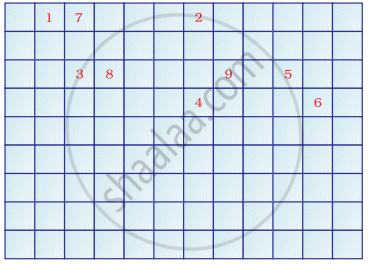Advertisements
Advertisements
प्रश्न
A non-metal X which is the largest constituent of air combines with hydrogen when heated in the presence of iron as catalyst to form a gas Y. When gas Y is treated with sulphuric acid, it forms a compound Z which is used as a chemical fertiliser.
(a) What are X, Y and Z?
(b) To which group of periodic table does X belong?
(c) Name the periodic table in which X is placed.
(d) Which element is placed just before X in the period?
(e) Which element is placed just after X in the period?
उत्तर
(a) Element X is Nitrogen gas (N2) since the largest constituent of air is nitrogen. When nitrogen reacts with hydrogen in the presence of iron as a catalyst, ammonia (NH3) is formed. Therefore, Y is ammonia (NH3). When ammonia reacts with sulpuric acid, ammonium sulphate is formed which is used as a chemical fertilizer. Therefore, Z is ammonium sulphate (NH4)2SO4.
(b) Nitrogen belongs to group 15 of the periodic table.
(c) Nitrogen is placed in the second period of the periodic table.
(d) Carbon (C) is placed just before nitrogen in the period.
(e) Oxygen (O) is placed just after nitrogen in the period.
APPEARS IN
संबंधित प्रश्न
As element X has mass number 40 and contains 21 neutrons in its atom. To which group of the periodic table does it belong?
An atom has the electron structure of 2, 7.
(a) What is the atomic number of this atom?
(b) To which of the following would it be chemically similar?
7N, 15P, 17Cl, 18Ar
(c) Why would you expect it to be similar?
An element X from group 2 of the periodic table reacts with an element Y from group 17 to form a compound.
(a) What is the nature of the compound formed?
(b) State whether the compound formed will conduct electricity or not.
(c) Give the formula of the compound formed.
(d) What is the valency of element X?
(e) How many electrons are there in the outermost shell of an atom of element Y?
Two elements X and Y belong to group 1 and 2 respectively in the same period of periodic table. Compare them with respect to:
(i) the number of valence electrons in their atoms
(ii) their valencies
(iii) metallic character
(iv) the sizes of their atoms
(v) the formulae of their oxides
(vi) the formulae of their chlorides
Choose the correct option and rewrite the statement.
The number of electrons in the outermost shell of alkali metals is _______.
Elements belonging to the same group have the same valency.
The basis of the classifications proposed by Dobereiner, Newlands and Mendeleev was ______.
Which one of the following statements is not correct about the trends in the properties of the elements of a period on going from left to right?
Complete the following cross word puzzle
Across:
(1) An element with atomic number 12.
(3) Metal used in making cans and member of Group 14.
(4) A lustrous non-metal which has 7 electrons in its outermost shell.
Down:
(2) Highly reactive and soft metal which imparts yellow colour when subjected to flame and is kept in kerosene.
(5) The first element of second Period
(6) An element which is used in making fluorescent bulbs and is second member of Group 18 in the Modern Periodic Table
(7) A radioactive element which is the last member of halogen family.
(8) Metal which is an important constituent of steel and forms rust when exposed to moist air.
(9) The first metalloid in Modern Periodic Table whose fibres are used in making bullet-proof vests

The atomic number of an element 'X' is 11.
- Write the electronic configuration of X and find its valency.
- Write the formula and nature of its oxide.
